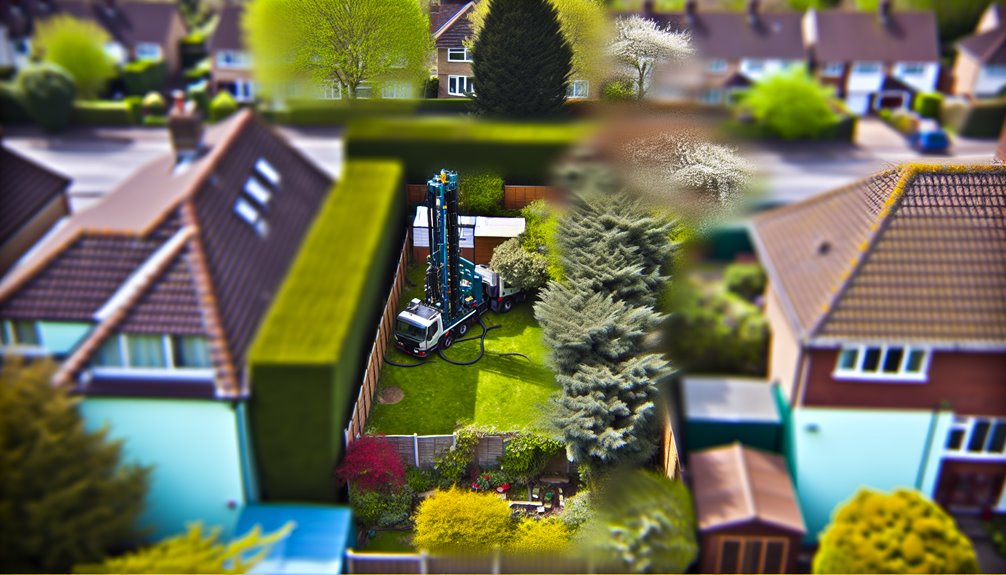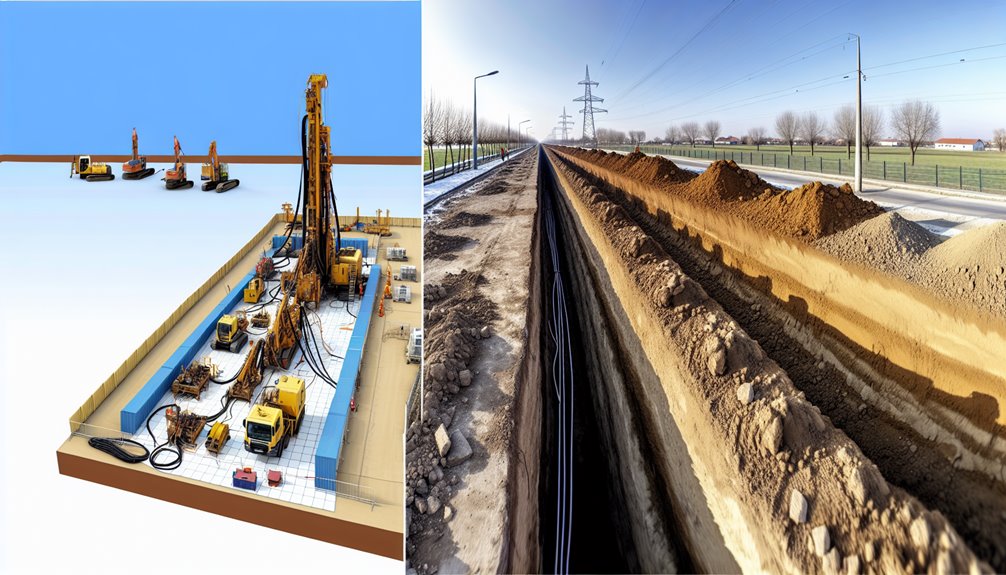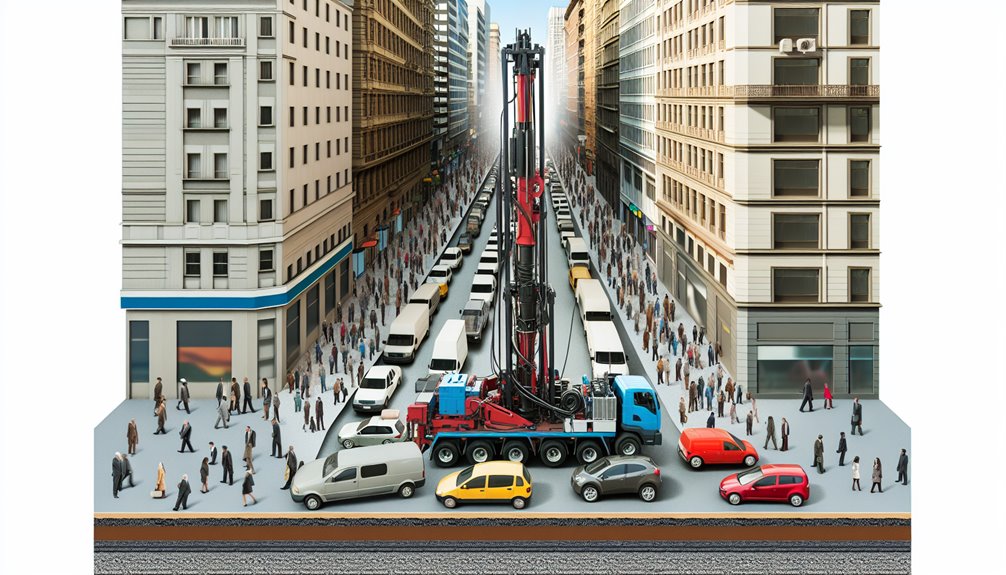You might often hear that Horizontal Directional Drilling (HDD) is only for large-scale projects, yet this is a common misconception. HDD technology is not only scalable but also highly precise, making it suitable for a variety of environments, including urban areas where minimal surface disruption is essential. Despite concerns about its cost, the long-term savings from reduced environmental impact and lower maintenance needs provide a compelling counterpoint. Curious about how HDD stands up to traditional methods regarding reliability and environmental footprint?
HDD Is Only for Large-Scale Projects

Although many believe that Horizontal Directional Drilling (HDD) is reserved for large-scale projects, this isn't the case.
You'll find that HDD thrives in small scale applications, especially when deploying utility cables or pipelines beneath roads or waterways. Mini HDD equipment, handling pipe sizes from 25mmØ to 180mmØ and capable of distances up to 100m, is perfectly suited for these tasks.
This method's adaptability allows it to manage projects varying widely in scope and complexity. Whether it's a short run beneath a local street or negotiating underground obstacles in congested urban areas, HDD's versatility enables precise, efficient installations with minimal disruption.
This adaptability makes HDD an invaluable tool in your project planning arsenal, fostering innovative solutions across varied environments. Mini HDD methods are particularly beneficial as they allow for a smoother installation process without the need for large-scale excavation or disruption.
HDD Causes Significant Environmental Damage
You might believe that horizontal directional drilling (HDD) causes considerable environmental damage, but it's important to take into account the facts.
HDD's controlled drilling path and minimal surface disruption greatly reduce the impact on natural habitats compared to traditional excavation techniques.
Furthermore, its ability to install infrastructure beneath sensitive areas, such as rivers and wetlands, preserves ecosystems and mitigates habitat destruction.
By bypassing underground obstacles and maintaining the integrity of the surface, HDD ensures that natural habitats are minimally impacted.
Minimal Surface Disruption
Despite common beliefs, horizontal directional drilling (HDD) greatly reduces surface disruption, especially when compared to conventional excavation techniques.
You'll find that HDD aligns with sustainable infrastructure goals by minimizing the impact on landscapes and ecosystems. This method allows for underground installations beneath sensitive areas like wetlands and rivers without disturbing their natural state or habitat, thereby preserving ecological integrity.
Moreover, HDD supports eco-friendly infrastructure development, reducing the need for extensive surface excavation and mitigating potential environmental damage.
By maintaining the surface integrity, HDD lessens the risk of soil erosion and habitat destruction, contributing considerably to environmental conservation.
It's a preferred choice in areas of high environmental sensitivity, ensuring that sustainable practices are at the forefront of infrastructural advancements.
Controlled Drilling Path
While horizontal directional drilling (HDD) offers significant surface-level benefits, it can also cause substantial environmental harm, particularly in relation to groundwater and soil contamination.
You must understand that the drilling techniques employed can inadvertently lead to the interconnection of groundwater from different geologic deposits, introducing pollutants. Environmental safeguards like effective sealing of boreholes and meticulous emergency response planning are essential to mitigate these risks.
Furthermore, inadvertent returns of drilling mud, containing harmful chemicals, pose a serious threat by increasing water turbidity and altering aquatic ecosystems.
It's imperative to embrace advanced drilling techniques and robust regulatory frameworks to guarantee these environmental risks are effectively managed and minimized, safeguarding critical natural resources.
Reduced Habitat Impact
Although horizontal directional drilling (HDD) greatly reduces surface disruption, it's important to recognize its substantial environmental implications, particularly concerning habitat impact.
- Wildlife Corridors Preservation: HDD helps maintain critical wildlife corridors, ensuring that animal migration patterns aren't disrupted by physical barriers, which is essential for maintaining biodiversity.
- Ecosystem Preservation: By avoiding large-scale surface excavation, HDD minimizes the impact on local ecosystems. This technique preserves the integrity of wetlands and other sensitive environments, markedly reducing habitat fragmentation.
- Mitigation of Environmental Risks: Despite its benefits, HDD requires meticulous planning to avoid inadvertent returns of drilling fluids, which could threaten water sources and local habitats.
Effective risk management is imperative to sustain ecosystem health and function.
HDD Is More Costly Than Traditional Drilling Methods

Given the complexities involved, you might assume that horizontal directional drilling (HDD) invariably costs more than traditional drilling methods.
However, when you dissect the cost factors and potential investment returns, the narrative shifts. Initially, HDD's equipment and setup costs are higher, but these are offset by significant savings in environmental restoration, reduced surface disruption, and lower long-term maintenance.
In urban and ecologically sensitive areas, HDD outstrips traditional methods in cost efficiency due to minimal landscape and infrastructure disruption.
Furthermore, the adaptability of HDD to cross under obstacles like rivers and highways without extensive groundwork further tilts the cost-benefit analysis in its favor, especially for projects where long-term cost savings are prioritized over short-term expenditures.
HDD Is Only Useful for Installing Water and Sewer Lines
You might believe that horizontal directional drilling (HDD) is confined to installing water and sewer lines, but its utility extends much further.
It's essential for laying electrical cables in urban settings and sensitive areas, where minimizing surface disruption is paramount.
Additionally, HDD supports a broad range of utility applications, efficiently accommodating different materials and soil conditions.
Versatile Utility Applications
Despite common beliefs, horizontal directional drilling (HDD) isn't limited to just water and sewer line installations; it's a highly versatile technology used across various sectors.
You'll find that HDD greatly enhances drilling efficiency and supports complex utility infrastructure projects beyond mere basic needs.
- Telecommunications: HDD is essential for deploying fiber-optic cables critical for high-speed internet, ensuring minimal disruption in densely populated urban areas or sensitive ecological zones.
- Gas and Oil Lines: This method allows for the precise installation of pipelines in challenging terrains, reducing environmental impact and surface excavation.
- Environmental and Cleanup Projects: HDD is vital in projects like installing environmental wells or managing groundwater quality, especially in locations where traditional methods are too invasive.
Electrical Cable Installation
Building on the versatility of horizontal directional drilling in multiple sectors, it's important to address another widespread application: electrical cable installation.
HDD excels in deploying a variety of cable types, including power transmission and fiber-optic cables. This method offers precise control through advanced tracking technologies, ensuring cables are accurately placed even under rivers or busy highways.
The installation process minimizes environmental impact and disruption by avoiding large trench excavations. Moreover, HDD supports efficient installations from offshore wind farms, bringing power cables ashore seamlessly.
These capabilities make HDD not only suitable but also preferred for complex electrical installations where minimizing surface disruption and maintaining environmental integrity are vital.
HDD Cannot Be Used in Urban Areas

Although some believe that horizontal directional drilling (HDD) is unsuitable for urban areas, this view overlooks its significant advantages in densely populated settings.
Here's why HDD is actually ideal for urban infrastructure:
1. Minimized Surface Disruption: HDD avoids significant surface excavation, reducing impact on traffic and local businesses.
It's a game-changer in maintaining daily urban life while upgrading infrastructure.
2. Environmental Preservation: This drilling technology minimizes ecological footprints by preserving urban landscapes and water bodies, ensuring less disruption to local ecosystems and historical areas.
3. Technical Precision: Advanced geotechnical analysis supports HDD's ability to navigate complex urban undergrounds with precision, avoiding existing utilities and optimizing routes for new installations, even under buildings or busy streets.
HDD Technology Lacks Precision and Reliability
While some argue that horizontal directional drilling (HDD) lacks precision and reliability, the facts suggest otherwise.
HDD precision is remarkable, achieving accuracy within 0.01 to 0.04 degrees of your target. This high level of accuracy is sustained by real-time tracking during pilot hole drilling, employing advanced magnetic and gyro steering technologies.
Magnetic steering, particularly with DC tracking, offers superior accuracy due to its unique wire loop configuration. Conversely, gyro steering, impervious to magnetic disruptions, continuously tracks movements in pitch, yaw, and roll via optical fiber cables.
Additionally, HDD reliability in practical applications is evident as it adeptly navigates under rivers and highways, maintaining high productivity and cost-effectiveness in diverse environments, thereby dispelling doubts about its dependability.
Conclusion
You've seen how misconceptions about Horizontal Directional Drilling (HDD) don't hold up under scrutiny. HDD isn't just for large-scale projects; it's equally efficient for smaller ones and causes minimal environmental disruption compared to traditional methods. Its upfront costs are offset by long-term savings, and its versatility extends beyond water and sewer lines to various urban and rural applications. Furthermore, HDD's technological advancements guarantee both precision and reliability, making it an excellent choice for modern infrastructure needs.
If you're curious to learn more about how HDD can benefit your next project, I invite you to visit Boring Bros at boringbro.com. You can also give us a call at (954) 639-6167. We're here to help and would love to chat about how we can assist you with your drilling needs!

